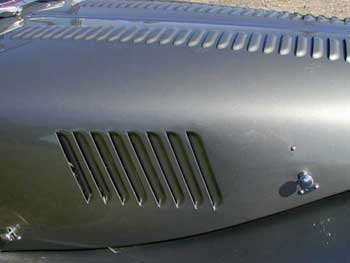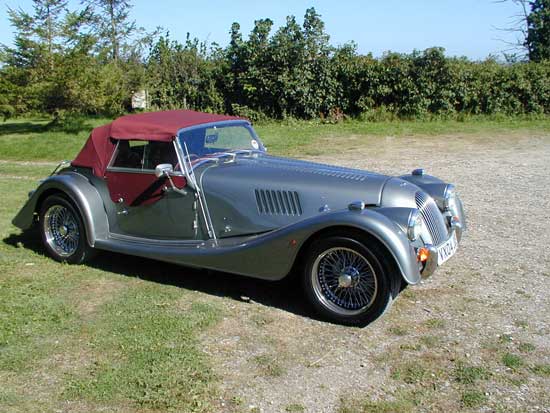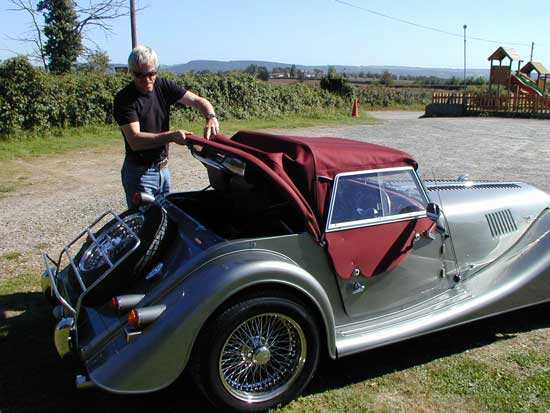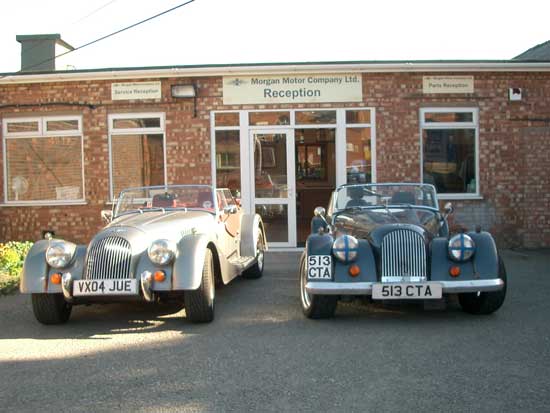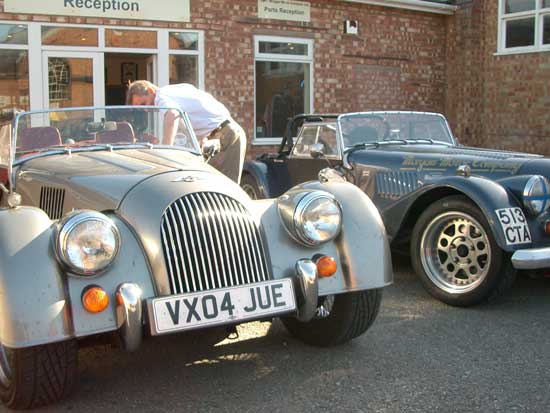Driving the car
There are 2 types of seats available, the fixed back bucket or a new reclining
seat - the demonstrator was fitted with the latter. We instantly noticed
the seats felt hard and rather overpadded making us feel we were sitting
very high in the car. The backrest gave plenty of lateral support but we
found that they became uncomfortable quite quickly. In discussion later
with those at the Factory, we learned that Morgan had put a new foam in
these seats and had accepted the manufacturer’s claims as to the degree
of settling that should be experienced. Sadly, this proved not to be the
case and the Factory advised us that it is their intention in the future
to pump in more air so the foam becomes more compliant and comfortable.
The engine is clearly a gem, starting up, pulling away and idling cleanly.
We did feel a little softness or lag on the throttle take up but this may
just have been getting used to the feel of the car.
The clutch was rather more industrial with a sharp action that made
it difficult to pull away or change gears smoothly until you got used to
it.
The engine just keeps on revving and coupled with a smooth gearbox with
well spaced ratios and Morgan-designed remote gear shift made for very
rapid progress. The interesting point is that the engine will pull cleanly
in any gear from 1000 revs and probably less, so, although the torque figures
are lower than the +8, the difference on the road is far less apparent
than expected. From this point it revs freely right through the range.
You can take it up to 4000 revs as a rapid but civilized mode of transport
but take it beyond this and the car really takes off. This was very impressive
and certainly this would be a safe car for overtaking. We tested out some
of the intermediate acceleration figures ourselves with a hand-held stopwatch
with the following results:
30-50mph:
3rd 3.55secs
4th 4.66 secs
50-70mph
3rd 3.28 secs
4th 4.44 secs
5th 5.47 secs
The brakes were firm and progressive, pulling up straight and giving
confidence.
Despite the very hot day, and some time spent in queues behind tractors
and the citizens of Ledbury who seem to travel at no more than 30 mph,
there was no suggestion of overheating or of heat soak into the passenger
compartment. And when riding as a passenger we felt that there seemed to
be less wind noise and back draught than in the older Plus 8s – possibly
because the windscreen is raked more (introduced on LM62 cars) or because
the new car has side screens that come back further to the rear. For whatever
reason though, it made for a quieter and more pleasant ride and would be
nice for touring.
But, and it was a big BUT, all was not good. The engine, gearbox and
brakes were doing the right thing but we were struggling with the basic
feel of the car. Maybe the car had succumbed to repeated journalistic bashing
or constant Factory development pressure but the handling was clearly not
right.
Over the smallest irregularities in the road, and even cats’ eyes, the
steering wheel would snatch in your hands and scuttle shake set in. There
seemed to be little compliance in the suspension and progress over bumps
was uncomfortable. If you lifted off the throttle in a corner the car had
a tendency to lurch into a tighter line. It felt as though the tyres were
all at 50 psi, which they were not.
The ride was so bad that it was clear something was fundamentally wrong
with that particular car and it would have been a great shame had a journalist
been given it in that state. Having said that, for all intents and purposes
WE were the unlucky journalists for that day as the Factory supplied this
car for this review.
To add to our concern, upon our return to the Factory, we learned that
the car not been been tried before it was given to us and there was sad
surprise at our reaction. Yet others there, who had tried the car
recently, shared our view that something serious was amiss.
It seems so odd that a car should be offered for a public analysis if
it hasn’t been assessed as a perfect example of the type.
Conclusion
So our conclusion ? Well, it had been a long day getting to and from the
factory and we were rather jaded by the end of it, both by the travelling
and because we felt that we couldn’t fairly assess the model based on the
Factory demonstrator we were given. We both liked the engine and gearbox,
the weight distribution and the detailing of the car but strongly disliked
the suspension, clutch and seats.
How does it compare against the Plus 8? Well, that’s a difficult one.
First, which Plus 8 as they all had different characteristics. Taken generally
the Roadster engine and gearbox compare very favourably to the V8 and the
Rover gearbox. The creature comforts are better and the finish is good
but it’s no longer a cheap sports car. When the Plus 8 began its reign
in 1968 it cost £1155 - now the Roadster is £35,000 in basic
form and is pitched against the Porsche Boxster S with other sports car
coming in at half its price.
For the Morgan aficionado it stacks up well and the performance is good,
both for touring and ‘for sporty drive’ (as my Yokohamas say on the rims).
But the suspension must be sorted and the seats need to be improved if
customers are going to be happy with this car straight out of the box.
Of course, it is a tradition for Morgan owners to customize their cars,
so we can expect a huge discussion about the benefits of different exhausts,
ECUs, tyres, etc, but it should be possible for the basic car to be sufficiently
good for the owner not to feel he has to spend more to make it into the
car of his (or her) dreams.
|
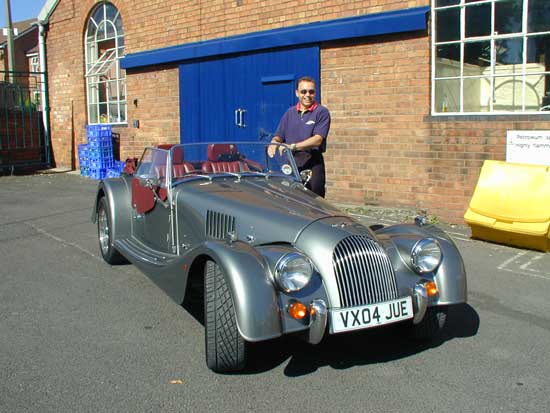 On
to the M4, up the dual carriageway past Swindon, Cirencester and
onto the M5, M50 and then through the winding lanes south of the Malvern
hills and finally turning in to Pickersleigh Road and the line of unpretenious
homes leading to the Morgan factory.
On
to the M4, up the dual carriageway past Swindon, Cirencester and
onto the M5, M50 and then through the winding lanes south of the Malvern
hills and finally turning in to Pickersleigh Road and the line of unpretenious
homes leading to the Morgan factory.
